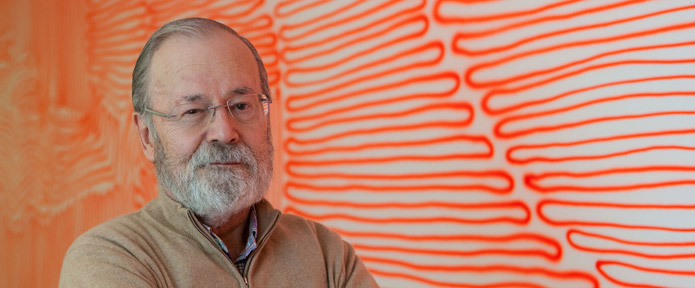Frederick Melville: "There would have been no artists like Michelangelo if it were not for the patrons".
The significant financial donation of this Anglo-Latin philanthropist led to the creation of the endowment, the Museum's monetary fund.

"There would not have been a sculptor like Michelangelo if it were not for the patrons, the promoters of art. Today that role is carried out by art centers such as the Museo Universidad de Navarra," said Frederick Melville after the recent signature of the contract of his donation to the Museum. However, he recognizes that there are fewer and fewer patrons, perhaps because the figure of the "potentate" is discredited in society. "My reasons from A to Z are that I see this Museum as original because it reverses the roles, becoming the promoter of good artists," he explained. The important economic donation of this businessman based in Guatemala allows the Museum to create the 'endowment', a fund to capitalize resources from donations. From now on, the money included in this fund will generate interest that will be used to finance part of the costs generated by the promotion of artistic creation and production and the Museum's programming.
After studying a postgraduate program at the London School of Economics (LSE), Frederick Melville served for seven years in the British Armed Forces. He used to go skydiving. Now 74 years old and with five spinal operations, he states in a perfect Spanish: "You think you are immortal, but then invoice all the 'stupid things' you did when you were young happen to you".
His entrepreneurial facet is developed in Guatemala. He started working at Progreso, the first cement company in Latin America, which is part of his family business . He recalls that, when he left university, he had "his head swollen with theories". However, his father told him: "You'll forget everything here, because you're going to start gluing stamps". Frederick maintains that "he has been everything in life," as he learned the business by going through the different stages of concrete processing. He worked as a miller and as a baker, and also covered night shifts.
Now, five decades later, he combines his work as a director with cultural patronage. He is also closely linked to the university world, as he was the driving force behind the Universidad del Istmo, in Guatemala, and is the current president of its association de Amigos. Melville defends that each artistic creation expresses how a person sees the world through the prism of beauty. "Everyone, in his or her way of being, expresses. That is part of the human race and we must not forget it," he says. He conceives art as an expression of humanity, and explains that most museums exhibit the past. For him, the University of Navarra Museum "is not a museum in this sense", since "the University of Navarra Museum teaches the past by showing the present and, in addition, encourages creation, the future of the arts".
For this reason, he decided to support the Museum, which intends to move forward through donations of works and anendowmentfund. The generous contribution of the businessman has laid the foundation that will allow the development of the program of exhibitions, shows and creative activities. "I give a financial aid not to pay fixed expenses or a debt that I have, but for the exclusive promotion of the arts".
Finally, Melville wanted to share his life and professional experience to offer a committee to young entrepreneurs: "You think that in 80 years you have done everything you should have done, but you must dare to serve and not be served. There is a lot at stake, as opposed to just one life," he concludes.
The Museum is to be financed by financial contributions made altruistically by individuals, companies and institutions. This aid makes possible the construction of the building and the artistic programming. With the start-up of theendowment, the Museum is approaching one of the economic objectives it set from the beginning: to create an economic fund that, in the medium and long term deadline, will make it possible to finance the artistic activity. "Fromnow on, we hope to add new donations to this fund so that, in the future, we will be able to assume the total annual cost generated by our artistic creation programs. For this, there are still many steps to take and new patrons and patrons to welcome, but today we have begun the journey," says Ángel Gómez Montoro, president of the Museum's board of trustees.
